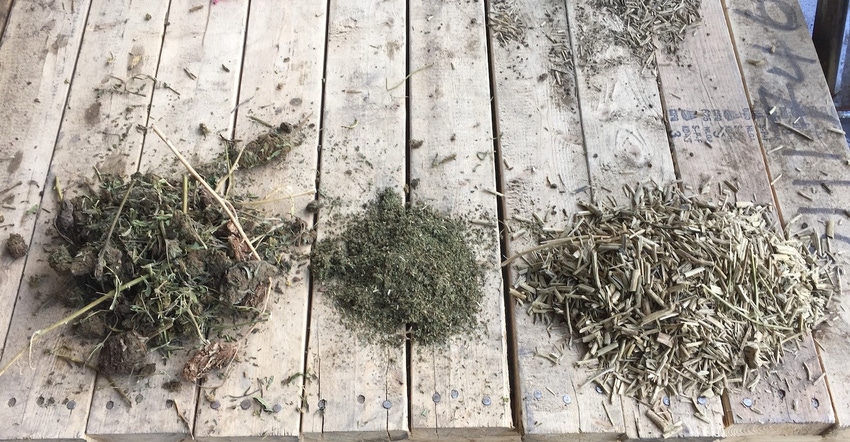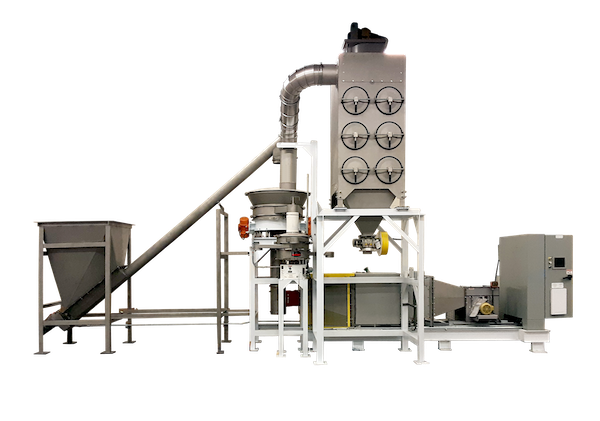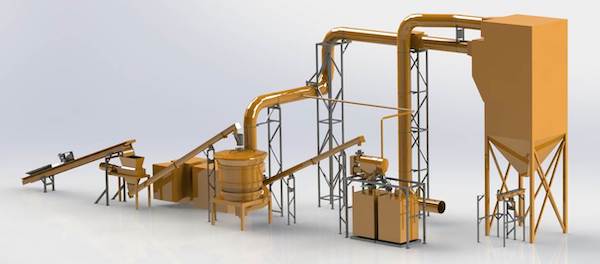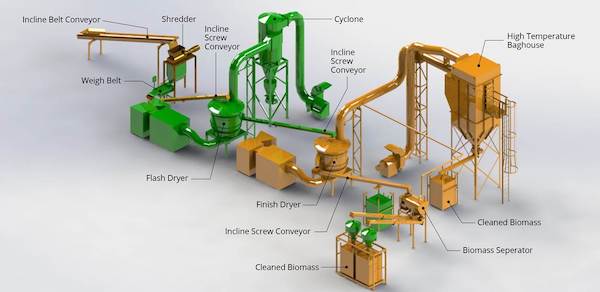Columbia Hemp Trading Engineers New Biomass Processing Approach
Learn how the company worked with ABM Equipment and Kason Corp. to overcome a number of hemp processing challenges.
June 17, 2021

In 2018, native Oregonian and local hemp and vegetable farmer Billy Toshef sensed that his home state was on the precipice of a unique opportunity for positive, transformative growth through cannabis.
Could he leverage the crop in a way that improved the health and wellbeing of the people and farming community, supporting independent farm ownership while also providing new jobs and income for farmers and workers? The hemp industry needed a home port in Oregon, and Toshef felt that he had the vision and the means to spearhead the initiative. His partner Jacob Crabtree agreed, and so the duo launched Columbia Hemp Trading Co. to put their plan into motion.
The startup posed some initial challenges. While Tosheff and his new colleagues had ample experience in organic farming and processing, they quickly realized that the characteristics of cannabis posed distinctive logistical problems from a harvesting and distribution standpoint.
If they had any hope of ramping up production and achieving their mission of bringing the benefits of hemp and CBD to a global community, they needed to first address the challenges specific to cannabis drying and processing in an environment that lacked industry background and experience to lean on.
As their volumes increased in tandem with their understanding of the complexities of hemp and cannabis drying, CHTC turned to a longtime processing partner ABM Equipment of Vancouver, WA, for help. For the venture to have a fighting chance of taking off in what was quickly becoming a competitive business landscape, it was critical that they equipped themselves with an integrated system capable of higher quality output, faster throughput, and massive cost reductions.
The call led to a unique three-way partnership between CHTC, ABM and Kason Corp. of Millburn, NJ, a well-known screening and processing equipment manufacturer with decades of success at demanding food- and pharmaceutical-grade applications. The collaboration led to the development of an innovative biomass processing system that features unique, patent-pending dual-stage drying technology. Thanks to ABM and Kason’s built-to-spec solution, the integrated continuous processing system has provided CHTC dramatic performance and cost advantages while finally giving the company a platform to scale to full-acreage crop volumes.
The innovative system has reduced production costs by more than 50% while preserving the terpene content, color, and aroma of the processed plant. The biomass processing equipment has also provided much-needed consistency in the drying process, targeting a 10% moisture content of the processed biomass at ambient temperature.

Challenges:
• Physical Characteristics: Compared to other biomass products, its inherent stickiness and toughness makes cannabis more challenging to process.
• Variability: Crops vary widely based on strain, soil conditions, weather, and other factors – each crop may require different settings for processing.
• Rapid Throughput: When crops are ready to be harvested, it must be dried within a week of harvesting. Otherwise, processors run the risk of having the biomass begin to decompose. Harvests come in at specific times of year and cannot be spaced over time.
• Cannabinoid Preservation: The cannabis drying process must retain crops’ CBD and THC content.
• Aesthetic Quality: Product should look and smell like cannabis. Heat-only dryers cause a slight browning which reduces market value.
• Sudden, Unpredictable Peaks: Weather conditions have a significant impact on harvest volumes. If it rains, all farmers need to take in their crop simultaneously and rapidly.
• Prices: Biomass prices for cannabis have gone down from premium to commodity or liquidity pricing, dropping by 90% in just 3 years.
Cannabis Processing: Overcoming Challenges Together
Suffice to say, hemp is unlike any other biomass product. Its unique properties require delicate yet efficient separation and processing to avoid degradation or decomposition.
“We decided to do what seems like the most difficult processing job there is: take truckloads of hemp that often come in all at once, by inventing new systems that don’t tend to damage the crop the way existing equipment seemed to be doing,” said Jacob Crabtree, CEO of Columbia Hemp Trading Company. Many systems being used in the field were struggling, he said, because while they may have been successful when developed for other industries, the tough cannabis and hemp crop presented new drying and handling problems they were not engineered to solve.
If the plant is over-heated, he said, the product instantly becomes worthless. “In 2019, we had a million and a half pounds of biomass rejected because it fell way below the threshold for extraction,” says Crabtree.
CHTC initially used batch style-drying equipment, but that presented three challenges that needed to be eliminated to scale up production.
First, the process was labor-intensive, which is difficult enough in a high-margin market but clearly not sustainable in a market where prices have dropped 90%. Secondly, the moisture content rose when they moved out of the machine back to ambient temperature. Finally, the extreme temperatures used in drum or tumbler dryers were actually burning the product, causing a discoloration of the cannabis.
“The target we're going for is a 10% moisture content, still green in color, and retention of cannabinoids. What that means is that if it comes in at 8%, it's leaving at, let's say, 7.8% CBD content. With our other systems, we're getting some browning of the material. Now with the new continuous 2-stage Kason drying system, it’s coming out looking as green and natural as when it came in, with that retention of cannabinoids,” said Crabtree.
Kason filed for patent protection on the newly engineered system engineered by ABM Equipment in 2020 based around the 2-stage drying methodology. Rather than using extreme heat that is destructive to the hemp product itself, the patent outlines the use of a high-throughput fluid bed dryer – Kason’s VIBRO-BED system – that eliminates the common problem of burning of cannabis and hemp found with drum- or tumbler-based systems.

The new drying system utilizes various technologies for conveyance, particle size reduction and sorting of the hemp biomass, in addition to a fluid bed drying technology. By controlling the entire process, the ABM Equipment/Kason solution achieves results that are superior to belt or tumbler dryers.
The patent-pending system yields biomass output at a consistent 4-12% moisture content for safe year-round storage, retains a beautiful, green product color and preserves the original hemp smell consumers prefer. The process has already been proven in the field with customers at volumes of up to 8,000 pounds per hour of biomass per unit.
Why ABM: High Expertise, Low Risk
Early on, when the CHTC team recognized the specific difficulties, they were facing with a hemp crop, they turned to ABM Equipment because of its combination of high-quality equipment, biomass processing expertise, and its integration experience in customizing an end-to-end solution and tweak it until the results met Columbia’s standards.
“The biggest learning [curve] I had was understanding how organic material dries,” said Crabtree. “When I mentioned to Jeff Walling of ABM our objective of getting from 75% moisture content down to 10% and the problems we’d had, he knew intuitively what we were trying to accomplish. I think ABM has seen this along a lot of food products over the years, so they knew how to design a cannabis-purposed drying and separation system.”
The ABM team, together with CHTC – alongside several farmers – tested the system on a variety of crop variations to perfect the system.
“The entire industry is so new that the growers weren’t consistent in how they had been harvesting and drying,” recalled Tosheff. “They were asking me how to tell when the cannabis plant was ready to harvest, and nobody was coming in the same way twice. That quickly demonstrated the inefficiency and unpredictability of the process.”
If Tosheff’s mission was to help the farmers get the most yield from their crops amid rapidly dropping cannabis prices and increased competition, he knew it was critical to work with an integrator like ABM to bring the company decades of processing and biomass experience.
“We led the industry, developing something new that was more efficient, and not choking ourselves by making big capital equipment mistakes,” said Billy Tosheff, Founder, Columbia Hemp Trading Company. “The ABM and Kason combination enabled CHTC to realize lower start-up and operating costs, with the ability to grow incrementally as volumes increased.”
Reducing risk in the cannabis industry is essential, as the learning curve and the rapid changes within the marketplace can lead to changing requirements. With each harvest, growers become savvier, and the crops can change. The demands and developments in the medicinal and consumer markets also impact processing output requirements. With a more flexible modular system like the ABM-Kason approach, Tosheff said it has become easier to stay relevant and make changes with improvements in the process as the industry matures and progresses.
Technical Solution

The ABM solution includes:
Conveyance Model: ABT-36 Trough Belt Conveyor - Whole plant or loose product is fed into shredder. Multiple styles leveling weirs/product dependent. Belt speed varies.
Particle Size Reduction Model: AHS-3631 Shredder - Capacity is 8,000 PPH with a particle size of 1” minus. Consistent particle size provides the ability to use a fluid bed dryer and ensures consistently, thoroughly dried product.
Drying: Kason VIBRO-BED Fluid Bed Dryer - The Fluid Bed Dryer dries primarily by creating a fluidized bed of particles and using a relatively low heat to move the moisture out of the bed. Fluid bed drying ensures drying of the surface area of every single particle, resulting in a consistent output rapidly and without the need to elevate the temperature to a level that might damage the product.
Sorting: Kason CENTRI-SIFTER - The high-throughput centrifugal sifter separates flowers from stalks and stems. The active materials can be stored while the stock biomass can go on to secondary markets.
Packing: Model ABBP-2000 - Unit can be supplied with or without scaling package and comes standard with inflatable spout for positive seal around bulk bag neck. Packing is fully integrated into the continuous process, avoiding spillage or any type of loss of output from the sifter and ensuring safe storage of the dried product for year-round preservation.
Benefits:
• Moisture Content: Consistent 10% moisture content in every batch, at ambient temperature.
• Terpene Yields: Evidence of terpene yields as high as a 97.5%.
• Crop Integrity: Gentle drying preserves the verdant green color and aroma of product.
• High Throughput: Throughput as high as 8,000 pounds per hour per machine.
• Cost Reductions: Over a 50% reduction in production costs.
• Totally Integrated System: All five elements are engineered to work in tandem: conveying, shredding, separation, drying and packaging.
The Kason VIBRO-BED Circular Vibratory Fluid Bed Dryer uses heat as an accelerant rather than a primary driver for evaporation, preserving CBD at a higher yield than alternative technologies.
Fluid bed dryers are an improvement over belt or tumbler drying methods, as the fluid bed pushes air up through the product while it is being constantly shifted with vibration. This fluidizes and maximizes exposure to air, speeding the drying process while maintaining product integrity. Because the product is suspended over the airstreams, this method increases the surface area of the product being exposed to dry air for greater efficiency and drying consistency.
Belt dryers in contrast pull air from above via vacuum, which creates concentrated or localized air streams that require higher temperatures and/or more time to remove inevitable wet spots that occur throughout the biomass.
Cannabis processors are also able to use the Kason VIBRO-BED fluid bed dryer to capture and return lost trichomes to each batch.
Kason and ABM Equipment together developed the patent-pending 2-stage drying approach for cannabis processing to address the technical shortcomings of single-stage units. Single-stage units use flash drying or extreme heat temperatures that attempt to reduce moisture content completely in one operation; the much higher temperatures lead to uneven drying and/or burning that damages the product and removes CBDs.
Kason’s 2-stage approach uses controlled temperatures throughout the process, which not only yields a better end-product but also leads to lower energy costs. The first stage removes up to 30% moisture content, while the second stage completes the process achieving the final output of 4-12% moisture content.
“We had significant contact on our platform, and I think we survived a lot of risk in the beginning,” Tosheff said. “Finding a reliable continuous processing system that is not only more efficient but safer to operate was critical for us to move forward. Every farmer has different fields, soils, conditions, growing environments and equipment. We’ve found a way to conquer that variability and produce a consistent, premium product in a processing platform that can grow alongside our industry.”
About Columbia Hemp Trading Co.
Columbia Hemp Trading Co. is the regional leader in the industrial hemp marketplace, having established a large-scale operation hemp drying, extraction and trading. CHTC was envisioned by co-founder Billy Tosheff, a local vegetable and hemp farmer. Unlike other commercial entrants into the emerging hemp industry, CHTC prioritized the most difficult segments of the supply chain beginning by solving the lack of critical infrastructure available to stabilize the biomass. With an initial objective of supporting Oregon’s farmers, CHTC has established drying facilities in Corvallis and Molalla, OR, providing reliable channels for Oregon’s farmers to sell and process their crops and be assured of high-quality output. CHTC is committed to defining and improving upon best practices for the industrial hemp supply chain from genetics to bulk formulations, and everything in between. CHTC believes that supply chain control, quality, and transparency are the critical ingredients to bringing the benefits of hemp to the world.
About the Author(s)
You May Also Like





